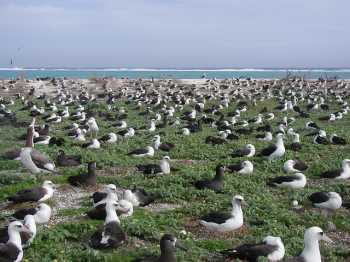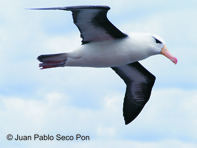Anicee Lombal (School of Biological Sciences, University of Tasmania, Hobart, Australia) and colleagues have published in the journal Conservation Genetics on genetic differences in two populations of Flesh-footed Shearwaters Ardenna carneipes.
“Increasing evidence suggests foraging segregation as a key mechanism promoting genetic divergence within seabird species. However, testing for a relationship between population genetic structure and foraging movements among seabird colonies can be challenging. Telemetry studies suggest that Flesh-footed Shearwater Ardenna carneipes that breed at Lord Howe Island or New Zealand, versus southwestern Australia or Saint-Paul Island in the Indian Ocean, migrate to different regions (North Pacific Ocean and northern Indian Ocean, respectively) during the non-breeding season, which may inhibit gene flow among colonies. In this study, we sequenced a 858-base pair mitochondrial region and seven nuclear DNA fragments (352–654 bp) for 148 individuals to test genetic differentiation among colonies of Flesh-footed Shearwaters. Strong genetic divergence was detected between Pacific colonies relative to those further West. Molecular analysis of fisheries’ bycatch individuals sampled in the Sea of Japan indicated that individuals from both western and eastern colonies were migrating through this area, and hence the apparent segregation of the non-breeding distribution based on telemetry is invalid and cannot contribute to the population genetic structure among colonies. The genetic divergence among colonies is better explained by philopatry and evidence of differences in foraging strategies during the breeding season, as supported by the observed genetic divergence between Lord Howe Island and New Zealand colonies. We suggest molecular analysis of fisheries’ bycatch individuals as a rigorous method to identify foraging segregation, and we recommend the eastern and western A. carneipes colonies be regarded as different Management Units.”

Flesh-footed Shearwater, photograph by Barry Baker
Reference:
Lombal, A.J., Wenner, T.J., Lavers, J.L., Austin, J.J., Woehler, E.J., Hutton, I. & Burridge, C.P. 2017. Genetic divergence between colonies of Flesh-footed Shearwater Ardenna carneipes exhibiting different foraging strategies. Conservation Genetics doi:10.1007/s10592-017-0994-y.
John Cooper, ACAP Information Officer, 11 July 2017

 English
English  Français
Français  Español
Español 


